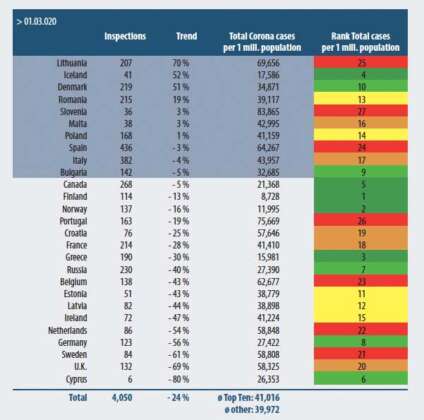
Trends in PSC inspections: keeping the Corona-virus implications in perspective
A guest commentary: Alexander Schepers, SMS Bereederung
[ds_preview]Most of the world’s population and economy is struggling as they slide from lock-down to lock-down. The backbone is the seaborne trade and their seafarers (#neptunedeclaration – https://www.globalmaritimeforum.org/neptune-declaration). Many of the crews have faced severe tragedy and had to accept to stay on board sometimes beyond a healthy mental and even physical condition. Crews keep ships running and the supply of population and economy up. But governments have for a long time not been able to implement their role as key workers and enable their travelling, let alone a priority status for vaccination.
The first lockdown in March 2020 was followed by a short period of easing during summer and autumn, but contact restrictions were again tightened in most European countries just before Christmas.
How have Port State Control authorities dealt with the situation in the 27 countries of the Paris Memorandum of Understanding (Paris MOU)?
By analysing a correlation between the Corruption Index and ports in some countries, some hotspots were identified. Ships investigated where less than 30 years of age (no tankers, RoRo or passenger ships less than 30,000GT).
The question is: Is there a correlation between the total infections per million population and number of inspections?
From European Maritime Safety Agency’s (EMSA) database, Thetis, the period of eleven months before 1 March 2020 was analysed and compared with the ten months thereafter and the total number of Covid infections per one million of population.
Not surprisingly, the total number of inspections has come down by about 1,200 (-24%). With some exceptions, the quota of detentions (number of detentions per number of inspections) remained stable at 3.2% and the average number of deficiencies eased by -12% to 2.21 per inspection.
A vessel is an enclosed environment with the crew often at sea for weeks. Considering the incubation time of the virus of a week or two, one would have thought these environments need to be protected especially – being the lifeline of supply for the economy.
Having said that, it comes to a surprise that for the top ten countries in this ranking of »Trend of inspection numbers«, the average of Covid cases by population is by 18% higher than for all the other member states of the Paris MOU (as of 10 February 2021)!
What are the reasons for the authorities of those countries with high infection rates like Lithuania, Romania, Malta, Poland and Slovenia to inflate the visits and not take appropriate action and avoid putting crew at risk of infection? And for the severely affected large population countries like Italy and Spain one would have thought they would have scaled down more in face of the risk of spreading the virus on board.
Of course, it can be debated if PSC officers would actually carry the virus on board when sticking to common safety practices. But a certain proximity to crew in narrow spaces or poorly ventilated accommodation could already be enough to spread the virus. Any avoidance would help!
Thinking a step ahead, is there actually a dedicated tracking or warning system in place for ships, on persons having been on board, who have been identified to be carrying the virus at the time of visit to a ship?
There is no doubt that PSC inspections are vital for a safe fleet and deficiencies need to be tackled with root cause analyses and preventive actions. In such times special attention needs to be drawn upon the crew’s welfare, payments and health condition.
Therefore, it needs to be discussed and further analysed what the focus of PSC in a member country should be. In order to keep up safety standards within the fleets calling ports of the Paris MOU, it would be advisable to specifically target ships and avoid visits to ships. With the EMSA’s publication of their database it is not possible to see the item code of the deficiency in a listed format. EMSA could extend their results with the codes of deficiencies in a way that it could be analysed more easily (now it is only possible by ship and inspection day).
Furthermore, it is worth noting that Belgium, Germany and Ireland have indeed showed (statistically) no mercy for ship managers and have increased their detention quota while issuing more deficiencies per visit.
The reasoning behind this could well be the targeting of vessels. Especially Germany and Belgium have significantly reduced their number of visits, but it seems they had a focus on certain ships, probably with a suspicion to be substandard.
The countries that have inflated or remained at the same number of inspections have mostly also not had any change in their detention or deficiency quota.
Breaking the methodology down to ports (11 months before Corona since the first lockdowns in March 2020 and until January 2021, within each time frame more than 10 PSC visits), there are only a few ports, which have indeed significantly increased their visits to ships, namely for example the Italian port of Salerno (11 visits before Corona and 25 until January 2021), which has also detained 20% of the vessels calling here. The previous 11 months Salerno authorities have not detained any vessel.
Lithuanian port of Klaipeda has also increased the number of visits significantly from 122 to 207. Shipowners can however rely seemingly on a fair inspection, as no detentions and hardly any deficiencies are being issued. The same goes for the ports of Galati (Romania), Esbjerg (Denmark) as well as Spanish Gijon and Aviles. These ports have increased visits by 50–100%, but the quality of ships calling here seems to be on a higher level, as detention- and deficiency ratios are on/below average.
Oppose to that the German ports have scaled significantly down on the number of visits but remarkably Bremen has detained 2 of 13 inspected vessels during the Corona times (previous period none).
Belgian’s port of Gent has scaled down significantly on their inspections (-53%), however with a detention ration up to 18% on 40 visits (previous period 4,7%). Here also the number of average deficiencies has increased to 6,8. The same pattern follows basically Antwerp (visits down –39% to 88, but 16 detentions and 7,2 deficiencies).
From the Russian ports only Kaliningrad has increased their visits moderately, but here no detentions and below average deficiencies have been issued. Only Rostov/Don, Murmansk, Kavkaz and Saint Petersburg were detaining ships, but to a low overall amount.
In summary, it is not a surprise that inspections are going down by numbers. But the described exceptions need to be discussed: countries and ports inflating their inspections could be asked to transparently reveal the reasoning behind it. Still, however, there is no accessible and responsive body who could be asked these questions.





















